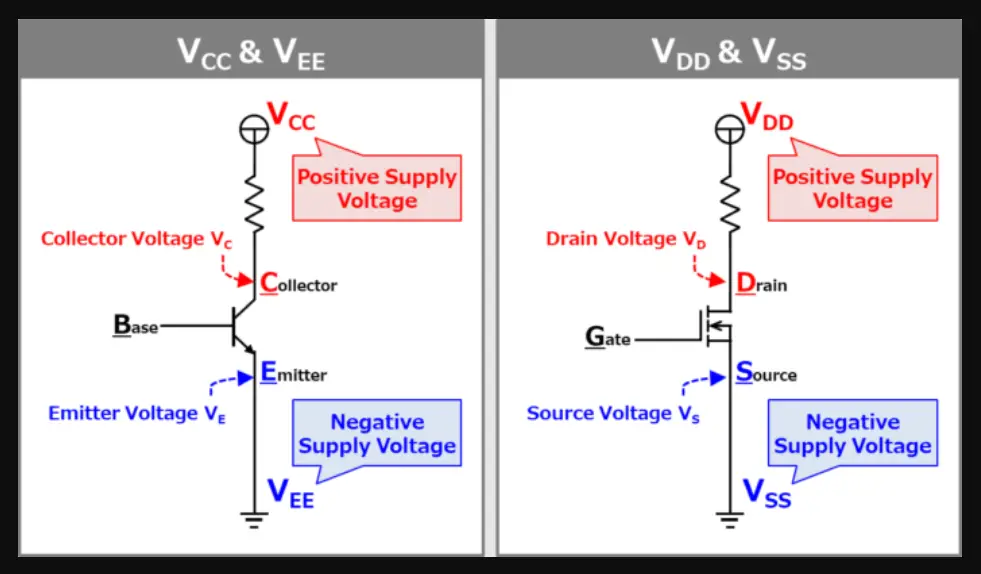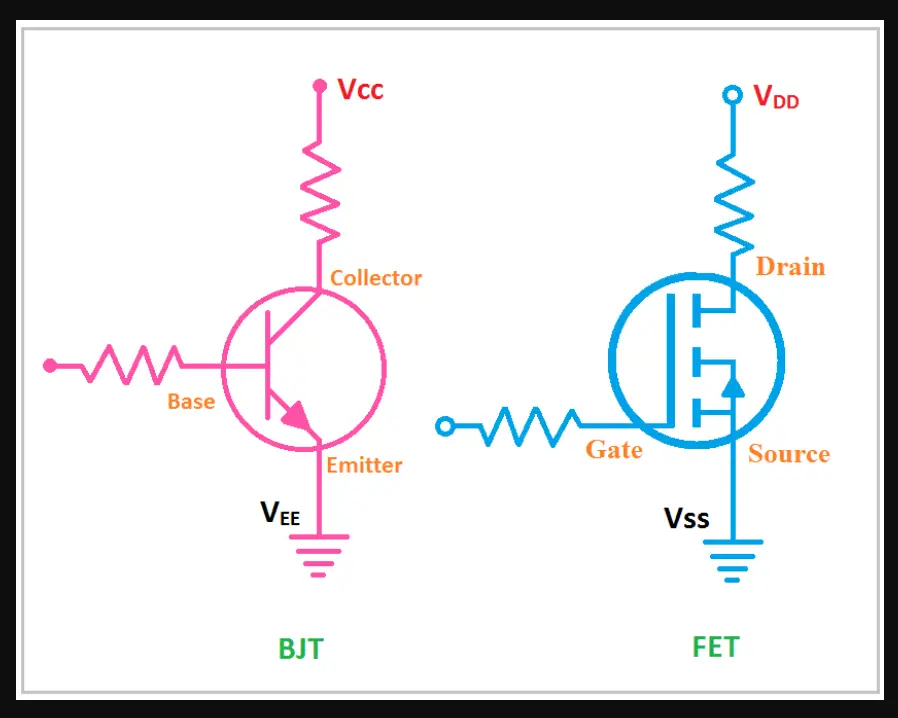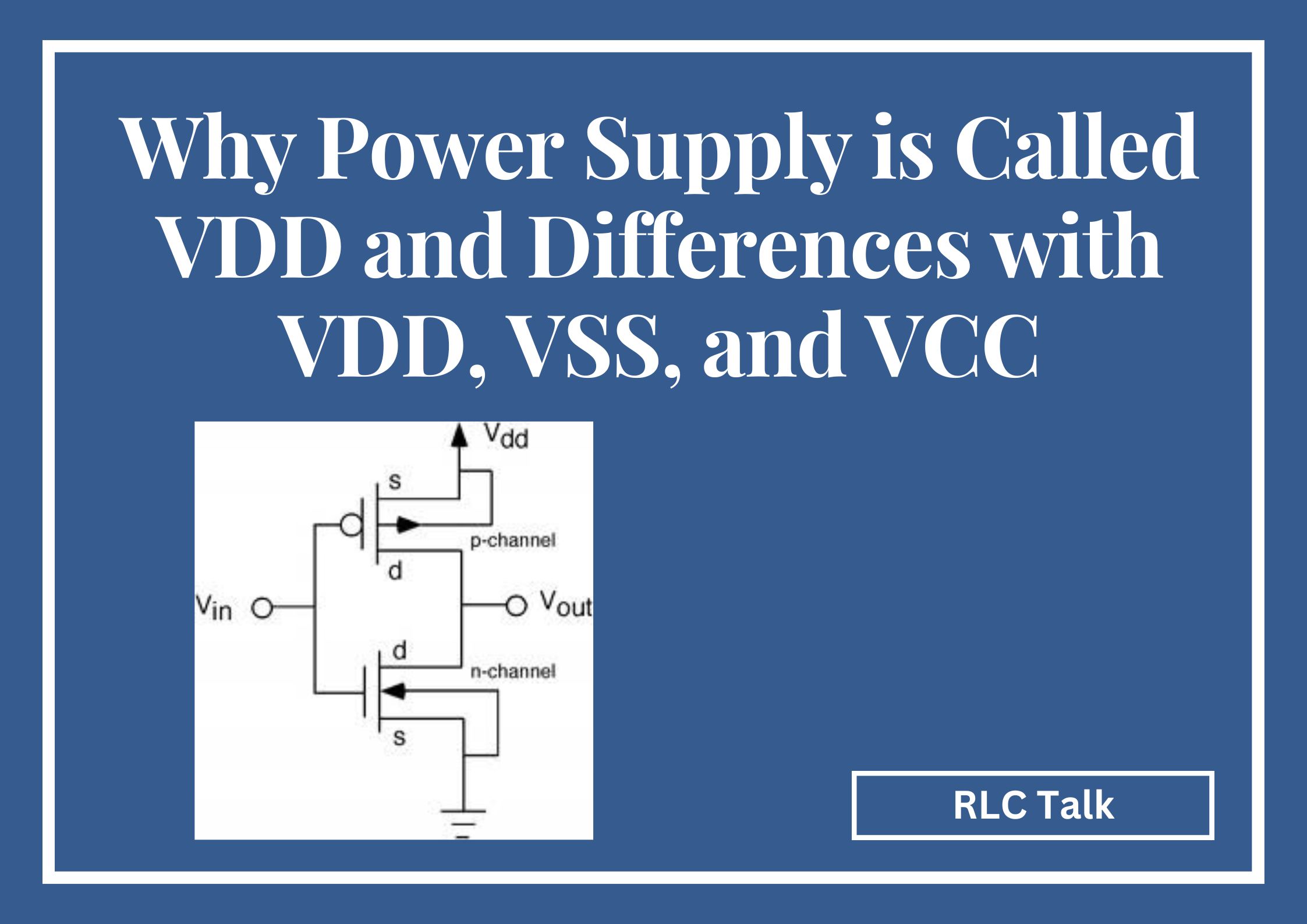Why Power Supply is Called VDD and Differences with VDD, VSS, and VCC
The term of these power voltages, which includes both VDD and VSS, has been mysterious and even slightly misleading from the beginning. In modern times, VDD and VSS are always used whenever one wants to refer to the positive and negative voltages, respectively.
VDD is usually 5V; however, these days, it’s closer to 3.3V or even less, like 1.8V or 1.2V. In the past, it was 5V. Nevertheless, when I was learning electronics in high school and during my initial few years of the field, I was informed that the positive voltage, which is generally 5 volts, is represented by VCC.
Yet, we discover pins labeled VSS and VDD when we come to certain circuits. Many people have not been fascinated by this; however, if you’re reading this, you are. In this article, we will cover why power supply is called VDD, as well as the differences between VDD, VSS, and VCC.
What Is VDD Meaning?
Why power supply is called VDD? The voltage that is linked to the drain of a Field Effect Transistor (FET) or Metal Oxide Semiconductor (MOS) device is known as the VDD supply voltage. This voltage acts as the primary power source for these devices and is frequently set at a greater level than the logic voltage applied to the system.
The level of the VDD voltage can change according to the gadget and the application, but on average, it is positive and works as the primary power source for the FET or MOS circuits. This level of voltage can change.
Is VDD Positive Or Negative?

In a field-effect transistor, the positive supply voltage is given by the notation VDD. This was addressed in the previous answer. As a result, the value of VDD must always be considered positive.
On the opposite hand, the reference voltage, also known as the ground voltage, is indicated by the notation of 0 volts and is represented by VSS. As a result, VDD and VSS are two voltage levels used in complementary electrical circuits, and VDD always represents the positive supply voltage.
What Is VDD In Mosfet?
The direct current (DC) voltage provided to the MOSFET transistor’s drain is the device’s VDD. It is a critical voltage to possess when influencing the transistor, as it affects how much of an amplified the transistor can deliver to an alternating current signal.
What Is The Difference Between VDD And VCC?

The following is a simple breakdown of the primary differences between VDD and VCC:
- Polarity: VDD is almost always a positive voltage, whereas VCC’s value can be either positive or negative, depending on the kind of bipolar device that is being used. In most circumstances, the voltage represented by VCC is positive.
- Indicating: The supply voltage for unipolar devices, such as MOS transistors, is represented by the term VDD, whereas the power supply voltage for bipolar devices, including such bipolar junction transistors, is represented by the term VCC (BJTs).
- Use: VCC is the value typically used as the power supply voltage for digital circuits that is part of the 74 series and voice-controlled carriers. The supply voltage for CMOS circuits and digital circuits of the 4000 series is typically denoted by VDD.
- Functionality: VDD indicates the operational voltage within the device, whereas VCC refers to the supply voltage available within the circuit. When considering digital circuits, the circuit’s supply voltage is commonly referred to as VCC, while the chip’s operating voltage is VDD. In most instances, VSS serves as the ground point.
- Component Pins: The drain of a field-effect transistor (FET) is represented by VDD, whereas VSS represents the source. On the other hand, VDD and VSS do not relate to the supply voltage but to the component pins.
In short, the most distinguishing factor between VDD and VCC is that the former is used in a larger number of electrical devices and circuits, while the latter is more usually related to positive voltage.
VDD vs VCC
| VDD | VCC |
|---|---|
| This does not relate to the supply voltage but rather the component pin. | Relates to the voltage that is being provided to the circuit or device. |
| The chip or device uses voltage while it is operating. | The voltage that is supplied to the circuit or device. |
| Hardly used by itself in CMOS circuits, it is frequently linked to a PMOS transistor. | In bipolar circuits, this is strongly associated with the collector of an NPN transistor. |
| MOS transistor circuits generally make use of this component. | Often found in circuits with bipolar transistors. |
Explained: The Science Behind Constant Current at Pinch-Off
RLC talk
VDD vs VSS
| VDD | VSS |
|---|---|
| VDD can be employed interchangeably with VCC once devices use a 5-voltage supply. | VEE is indeed negative same as VSS. |
| D in VDD relates to drain. | The letter S in VSS stands for “source.” |
| The positive voltage is the total voltage at an electric circuit’s VDD. | Devices powered by a negative supply, generally, 0V or ground, receive power from VSS. |
| It’s a type of AC voltage that keeps changing with every half-cycle of the AC waveform. | It is an alternating current ground potential. |
Conclusion
Why is a power supply called a VDD? In digital integrated circuits, the power supply voltage is known as “VDD,” which stands for “voltage drain.” Electrical circuits use VDD and VSS voltage levels, with VDD standing for the positive supply voltage and VSS for the ground or reference voltage.
VDD frequently appears in unipolar devices like MOS transistors, but VCC serves bipolar devices like BJTs. The primary distinctions between VDD and VCC are their polarity, which measures component use, functionality, and pins.
VDD usually indicates a positive outcome, but VCC can or may not. The chip or device uses VDD when functioning, whereas VCC refers to the voltage delivered to the circuit or device. MOS transistor circuits typically use VDD, but bipolar transistor circuits commonly use VCC.
Current Events: Can a Ground Wire Shock You or Just Electrify Your Life?
rlc talk








